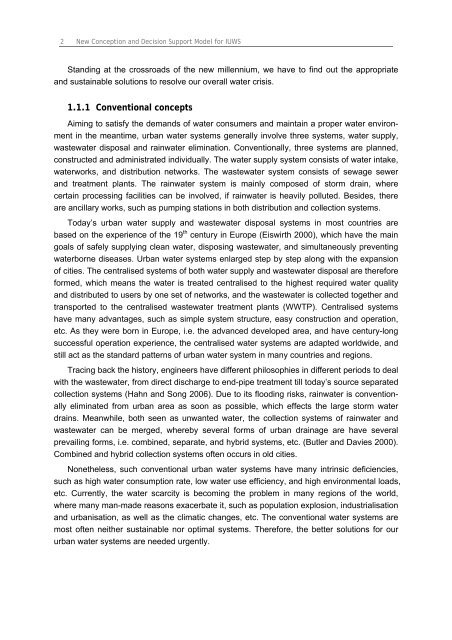Chapter 3 Decision Support Model (IUWS-DSM) - Tubdok
Chapter 3 Decision Support Model (IUWS-DSM) - Tubdok
Chapter 3 Decision Support Model (IUWS-DSM) - Tubdok
Create successful ePaper yourself
Turn your PDF publications into a flip-book with our unique Google optimized e-Paper software.
2 New Conception and <strong>Decision</strong> <strong>Support</strong> <strong>Model</strong> for <strong>IUWS</strong><br />
Standing at the crossroads of the new millennium, we have to find out the appropriate<br />
and sustainable solutions to resolve our overall water crisis.<br />
1.1.1 Conventional concepts<br />
Aiming to satisfy the demands of water consumers and maintain a proper water environment<br />
in the meantime, urban water systems generally involve three systems, water supply,<br />
wastewater disposal and rainwater elimination. Conventionally, three systems are planned,<br />
constructed and administrated individually. The water supply system consists of water intake,<br />
waterworks, and distribution networks. The wastewater system consists of sewage sewer<br />
and treatment plants. The rainwater system is mainly composed of storm drain, where<br />
certain processing facilities can be involved, if rainwater is heavily polluted. Besides, there<br />
are ancillary works, such as pumping stations in both distribution and collection systems.<br />
Today’s urban water supply and wastewater disposal systems in most countries are<br />
based on the experience of the 19 th century in Europe (Eiswirth 2000), which have the main<br />
goals of safely supplying clean water, disposing wastewater, and simultaneously preventing<br />
waterborne diseases. Urban water systems enlarged step by step along with the expansion<br />
of cities. The centralised systems of both water supply and wastewater disposal are therefore<br />
formed, which means the water is treated centralised to the highest required water quality<br />
and distributed to users by one set of networks, and the wastewater is collected together and<br />
transported to the centralised wastewater treatment plants (WWTP). Centralised systems<br />
have many advantages, such as simple system structure, easy construction and operation,<br />
etc. As they were born in Europe, i.e. the advanced developed area, and have century-long<br />
successful operation experience, the centralised water systems are adapted worldwide, and<br />
still act as the standard patterns of urban water system in many countries and regions.<br />
Tracing back the history, engineers have different philosophies in different periods to deal<br />
with the wastewater, from direct discharge to end-pipe treatment till today’s source separated<br />
collection systems (Hahn and Song 2006). Due to its flooding risks, rainwater is conventionally<br />
eliminated from urban area as soon as possible, which effects the large storm water<br />
drains. Meanwhile, both seen as unwanted water, the collection systems of rainwater and<br />
wastewater can be merged, whereby several forms of urban drainage are have several<br />
prevailing forms, i.e. combined, separate, and hybrid systems, etc. (Butler and Davies 2000).<br />
Combined and hybrid collection systems often occurs in old cities.<br />
Nonetheless, such conventional urban water systems have many intrinsic deficiencies,<br />
such as high water consumption rate, low water use efficiency, and high environmental loads,<br />
etc. Currently, the water scarcity is becoming the problem in many regions of the world,<br />
where many man-made reasons exacerbate it, such as population explosion, industrialisation<br />
and urbanisation, as well as the climatic changes, etc. The conventional water systems are<br />
most often neither sustainable nor optimal systems. Therefore, the better solutions for our<br />
urban water systems are needed urgently.

















